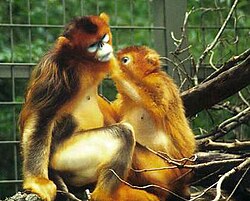| Common name | Scientific name and subspecies | Range | Size and ecology | IUCN status and estimated population |
|---|
| Black-and-white snub-nosed monkey  | R. bieti
A. Milne-Edwards, 1897 | Southern China
 | Size: 74–83 cm (29–33 in) long, plus 51–72 cm (20–28 in) tail [11]
Habitat: Forest [6]
Diet: Leaves, fruit, and lichen [11] | EN
1,000  [6] [6]
|
|---|
| Golden snub-nosed monkey  | R. roxellana
(A. Milne-Edwards, 1870)
- R. r. hubeiensis (Hubei golden snub-nosed monkey)
- R. r. qinlingensis (Qinling golden snub-nosed monkey)
- R. r. roxellana (Moupin golden snub-nosed monkey)
| Central China
 | Size: 57–76 cm (22–30 in) long, plus 51–72 cm (20–28 in) tail [12]
Habitat: Forest [5]
Diet: Leaves, bark, and lichen, as well as buds and fruit seeds [12] | EN
Unknown  [5] [5]
|
|---|
| Gray snub-nosed monkey  | R. brelichi
Thomas, 1903 | Central China
 | Size: About 64–73 cm (25–29 in) long, plus 70–97 cm (28–38 in) tail [13]
Habitat: Forest [7]
Diet: Leaves, buds, fruit, seeds and bark, as well as insect larvae [13] | CR
200  [7] [7]
|
|---|
| Myanmar snub-nosed monkey  | R. strykeri
Geissmann et al., 2010 | Northern Myanmar
 | Size: About 56 cm (22 in) long, plus 78 cm (31 in) tail [14]
Habitat: Forest [9]
Diet: Leaves, fruit, seeds, buds, flowers, twigs, and bark [15] | CR
350–400  [9] [9]
|
|---|
| Tonkin snub-nosed monkey  | R. avunculus
Dollman, 1912 | Northern Vietnam
 | Size: 51–65 cm (20–26 in) long, plus 66–92 cm (26–36 in) tail [16]
Habitat: Forest [8]
Diet: Leaves, fruit, flowers, and seeds [16] | CR
80–100  [8] [8]
|
|---|














